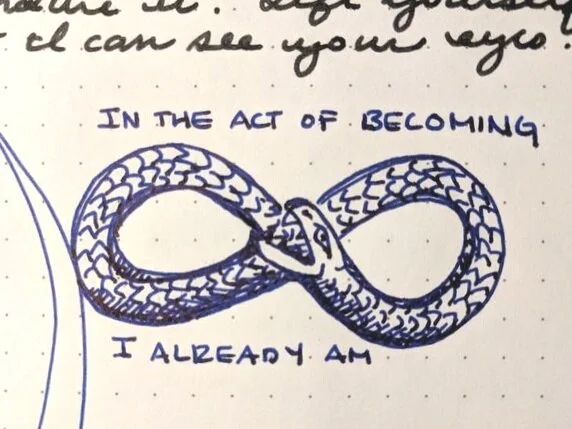What is an Ouroboros?
Put on your sable fedora, grab a whip, channel your inner Dr. Jones and dive into some archaeology with me:
Ouroboros comes from the Ancient Greek roots:
“Oura” - Tail
“Boros” - Eating
The serpent eating its own tail has been depicted in many version through history as a sign of “infinity” or the cycle of life and death that is maintained by the Universe.
The ancient symbol of a snake swallowing its tail - originally seen in the Enigmatic Book of the Netherworld, an ancient Egyptian funerary text in the tomb of Tutankhamen in the 14th century BC. The text is about the god Ra and his union with Osiris in the underworld. An illustration in the text depicts two serpents, holding their heads in their mouths which are coiled around an enormous god, sometimes thought of as the unification of Ra-Osiris. This divine figure is meant to represent the beginning and the end of time.
When abstracted these two ideas represent the cyclic renewal of life and infinity and have become a modern day representation of infinity or wholeness.
Ok, Cristina, we know you are an archaeology nerd but what does this have to do with yoga? So bear with me as we take a step back from the Indian Jones stuff.
From my Red Book Journal 2018
How the symbol of the Ouroboros resonates with me:
On or off the yoga mat it is common practice to view ourselves as incomplete, a work in progress, on the road to becoming…. This can become especially true when we view our yoga postures in comparison to an ideal: a perfect pose that has been fabricated in the photo lab of Yoga Journal or on the Instagram page of a social media star. “One day I will have a wheel / pigeon / dancer pose that looks like that.” Even looking around a yoga studio, it is difficult not to compare.
While setting personal goals and striving to be embody our best Self is a crucial part of growth, it is important to move away from the Western pitfall of seeing ourselves as not enough. There is a balance to be found in appreciation of your luminous Self as you are and growth. Often (particularly in the west) we set resolutions on New Years Eve: “This year I will ….”
The yogic tradition offers an alternative to the traditional resolution or fighting to change what / who we are based on comparison of the external. It is called: Sankalpa. We change the statement from “This year I will….” to “ I AM…”
This is something we can put into practice on and off the mat.
The sankalpa practice begins from the premise that you already are who you need to be to fulfill your life’s truth and deepest intentions (called dharma). Instead of changing who we are, sankalpa teaches us to focus our minds, to connect to our most heartfelt desires, and to channel the divine energy within ourselves.
When viewed this way, finding your sankalpa is just about listening to yourself. Our heartfelt desires and highest truths are already present waiting for us to notice. It is a practice of acute self awareness which requires patience and understanding.
We are that coiled snake of wholeness, infinity, beginning and end — we can contain these seemingly opposite states :


